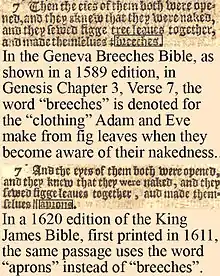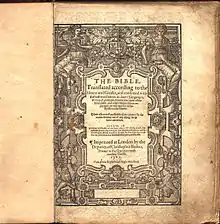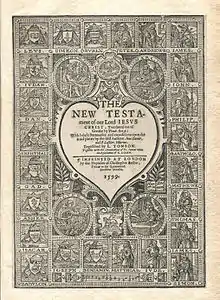Geneva Bible
The Geneva Bible is one of the most historically significant translations of the Bible into English, preceding the King James Version by 51 years.[1] It was the primary Bible of 16th-century English Protestantism and was used by William Shakespeare,[2] Oliver Cromwell, John Knox, John Donne, and others. It was one of the Bibles taken to America on the Mayflower. (Pilgrim Hall Museum has collected several Bibles of Mayflower passengers.) The Geneva Bible was used by many English Dissenters, and it was still respected by Oliver Cromwell's soldiers at the time of the English Civil War, in the booklet The Souldiers Pocket Bible.[3]
| Geneva Bible | |
|---|---|
 Geneva Bible 1560 edition | |
| Full name | Geneva Bible |
| Abbreviation | GEN |
| NT published | 1557 |
| Complete Bible published | 1560 |
| Textual basis | Textus Receptus |
| Religious affiliation | Protestant |
Genesis 1:1–3
In the beginning God created the heaven and the earth. And the earth was without forme and voyde, and darkeness was upon the depe, and the Spirit of God moved upon the waters. Then God said, "Let there be light" and there was light.
For God so loved the world, that he hath given his only be gotten Son, that whosoever beleveth in him, should not perish, but have everlasting life. | |
| The Bible in English |
|---|
|
|
|
This version of the Bible is significant because, for the first time, a mechanically printed, mass-produced Bible was made available directly to the general public which came with a variety of scriptural study guides and aids (collectively called an apparatus), which included verse citations that allow the reader to cross-reference one verse with numerous relevant verses in the rest of the Bible, introductions to each book of the Bible that acted to summarize all of the material that each book would cover, maps, tables, woodcut illustrations and indices.
Because the language of the Geneva Bible was more forceful and vigorous, most readers strongly preferred this version to the Great Bible. In the words of Cleland Boyd McAfee, "it drove the Great Bible off the field by sheer power of excellence".[4]
History
The Geneva Bible followed the Great Bible of 1539, the first authorised Bible in English, which was the authorized Bible of the Church of England.
During the reign of Queen Mary I of England (1553–58), because Mary I was Catholic, a number of Protestant scholars fled from England to Geneva, Switzerland, which was then ruled as a republic in which John Calvin and, later, Theodore Beza, provided the primary spiritual and theological leadership. Among these scholars was William Whittingham, who supervised the translation now known as the Geneva Bible, in collaboration with Myles Coverdale, Christopher Goodman, Anthony Gilby, Thomas Sampson, and William Cole; several of this group later became prominent figures in the Vestments controversy. Whittingham was directly responsible for the New Testament, which was complete and published in 1557,[5] while Gilby oversaw the Old Testament.
_School_-_Sir_Rowland_Hill_(1492%E2%80%931561)_-_1298284_-_National_Trust.jpg.webp)
The first full edition of this Bible, with a further revised New Testament, appeared in 1560,[5] and was published by Sir Rowland Hill of Soulton,[6][7][8][9][10] but it was not printed in England until 1575 (New Testament[5]) and 1576 (complete Bible[5]). Over 150 editions were issued; the last probably in 1644.[5] The first Bible printed in Scotland was a Geneva Bible, which was first issued in 1579.[5] In fact, the involvement of Knox (1514-1572) and Calvin (1509-1564) in the creation of the Geneva Bible made it especially appealing in Scotland, where a law was passed in 1579 requiring every household of sufficient means to buy a copy.[11]
Some editions from 1576 onwards[5] included Laurence Tomson's revisions of the New Testament. Some editions from 1599 onwards[5] used a new "Junius" version of the Book of Revelation, in which the notes were translated from a new Latin commentary by Franciscus Junius.
The annotations which are an important part of the Geneva Bible were Calvinist and Puritan in character, and as such they were disliked by the ruling pro-government Anglicans of the Church of England, as well as King James I, who commissioned the "Authorized Version", or King James Bible, in order to replace it. The Geneva Bible had also motivated the earlier production of the Bishops' Bible under Elizabeth I, for the same reason, and the later Rheims–Douai edition by the Catholic community. The Geneva Bible remained popular among Puritans and remained in widespread use until after the English Civil War. The Geneva notes were surprisingly included in a few editions of the King James version, even as late as 1715.[5]
| Part of a series on |
| Calvinism |
|---|
 |
|
|
Translation
Fleeing the persecution of Mary I, a team of Calvin's followers gathered in Geneva to produce an English-language Bible to reflect Protestant theology.
William Whittingham led a team of all-Calvinist theologians in producing the Geneva Bible from the existing Latin and English versions, including Miles Coverdale, Christopher Goodman, Anthony Gilby, John Knox, and Thomas Sampson.[12] Whittingham had worked on other English versions including Tyndale’s, Coverdale’s, Matthew’s and other partial English translations. Whittingham and the other “translators” had only basic knowledge of Ancient Hebrew, no understanding of Aramaic, and only an elementary understanding of Greek, and thus were unable to heavily rely on any ancient texts. Few older Greek and Hebrew manuscripts were available at the time, but there were some. For example, in 1516, Erasmus compiled and published a handful of older Greek Orthodox versions of the New Testament texts brought into Europe by Orthodox Christians fleeing the Fall of Constantinople in 1453. However, knowledge of Hebrew and Greek was basic among the Protestant reformers, particularly Koine.
Instead, they heavily relied on Tyndale’s English New Testament (which was translated mostly from the Latin Vulgate) and the Latin Vulgate directly, with references to Erasmus’s 1516 interlinear Latin-Greek Novum Instrumentum omne (which was also instrumental in the translation of the King James Bible) and to Theodore Beza's Biblia Sacra (a Greek version translated from the Vulgate, not the original Greek). Because ancient Greek and Hebrew were largely inaccessible to the Calvinist translators of that era, errors that had originated with the Vulgate were retained throughout their work.[13]
The first European translation of the Bible directly from Hebrew and Greek sources was a Catholic translation by Santes Pagnino called the Veteris et Novi Testamenti nova translatio in 1527. The Geneva translation, the Lutherbibel and all subsequent Protestant translations relied nearly exclusively on Jerome's Vulgate to varying degrees. The purpose of the Geneva Bible translation was polemic and reactionary and thus continued many deliberate mis-translations first made by Tyndale to use it as a weapon against Catholicism. These included rendering μετανοεῖτε (metanoeîte) as 'repent' instead of 'do penance', and ἐκκλησία (ekklēsía) as 'congregation' instead of 'Church'. The bulk of the text of the Geneva Bible is not Scripture, but commentary to ensure the reader interprets the text through Calvinist tradition.[14]
Format
The Geneva Bible was the first English Bible to use verse numbers based on the work of Stephanus (Robert Estienne of Paris, by this point living in Geneva). It also had an elaborate system of commentary in marginal glosses. This annotation was done by Laurence Tomson, who translated (for the 1560 Geneva Bible) L'Oiseleur's notes on the Gospels, which themselves came from Camerarius. In 1576 Tomson added L'Oiseleur's notes for the Epistles, which came from Beza's Greek and Latin edition of the Bible (1565 and later). Beginning in 1599 Franciscus Junius' notes on Revelation were added, replacing the original notes deriving from John Bale and Heinrich Bullinger. Bale's The Image of both churches had a great effect on these notes as well as Foxe's Book of Martyrs. Both the Junius and Bullinger-Bale annotations are explicitly anti-Roman Catholic and representative of much popular Protestant apocalypticism during the Reformation.
The 1560 Geneva Bible was printed in Roman type—the style of type regularly used today—but many editions used the older black-letter ("Gothic") type. Of the various later English Bible translations, the next to use Roman type was the Douay–Rheims Bible of 1582 (New Testament) and 1609–1610 (Old Testament).
The Geneva Bible was also issued in more convenient and affordable sizes than earlier versions. The 1560 Bible was in quarto format (218 × 139 mm type area), but pocketable octavo editions were also issued, and a few large folio editions. The New Testament was issued at various times in sizes from quarto down to 32º (the smallest, 70×39 mm type area[5]). In the late 16th century it is likely that the Geneva New Testament cost less than a week's wages even for the lowest-paid labourers.
The 1560 Geneva Bible contained a number of study aids, including woodcut illustrations, maps and explanatory 'tables', i.e. indexes of names and topics, in addition to the famous marginal notes. Each book was preceded by an 'argument' or introduction, and each chapter by a list of contents giving verse numbers. Smaller-format editions might be unillustrated and lack the marginal notes, but some large folio editions had additional illustrations, such as one showing Adam and Eve, where Adam wears a typical Elizabethan beard and moustache.

Breeches Bible
The Geneva Bible received the nickname "Breeches Bible," based on its unique translation of Genesis Chapter 3, Verse 7. The text reads: "Then the eies of them both were opened, and they knew that they were naked, and they sewed figge tree leaves together, and made themselves breeches." Previous English Bibles, such as the 1530 Pentateuch translation of William Tyndale, the 1535 Coverdale Bible, and the 1539 Great Bible, used the word apurns/aprons in this place. In the King James Version of 1611, "breeches" was changed to "aprons".

Modern spelling version of the 1599 Geneva Bible
In 2006, Tolle Lege Press released a version of the 1599 Geneva Bible with modernised spelling, as part of their 1599 Geneva Bible restoration project.[15] The original cross references were retained as well as the study notes by the Reformation leaders.[15] In addition, the Early Modern English glossary was included in the updated version.[15] The advisory board of the restoration project included several Protestant Christian leaders and scholars.[15]
King James I and the Geneva Bible

In 1604, the year after he ascended the English throne, King James I hosted and presided over a conference pertaining to matters religious, the Hampton Court Conference. While the Geneva Bible was the preferred Bible of Anglican and Puritan Protestants during the Elizabethan Age, the new king disliked the Geneva Bible and made his views clearly known at the conference: "I think that of all [English Bibles], that of Geneva is the worst." Apparently, his distaste for the Geneva Bible arose less from the translation than from the marginal annotations. He felt strongly many of the annotations were "very partial, untrue, seditious, and savoring too much of dangerous and traitorous conceits . . . ." In all likelihood, he saw the Geneva's comments upon biblical passages as anti-clerical "republicanism", which could imply that an ecclesiastical hierarchy was unnecessary. Other comments, notably references to monarchs as "tyrants", appeared particularly seditious.[16] It followed that the need for a king as head of church and state could be questioned, too. James had been dealing with similar issues with the Presbyterian-Calvinist religious leaders in his native Scotland, where he reigned as James VI, and he wanted none of the same controversies in England. Also, if annotations were in print, readers might believe these interpretations correct and fixed, making it more difficult to change his subjects' minds about the meanings of particular passages.

So when towards the end of the conference two Puritans suggested that a new translation of the Bible be produced to better unify the Anglican Church in England and Scotland, James embraced the idea. He would not only be rid of those inconvenient annotations, but have greater influence on the translation of the Bible as a whole. He commissioned and chartered a new translation of the Bible which would eventually become the most famous version of the Bible in the history of the English language. Officially known as the Authorized Version to be read in churches, the new Bible would come to bear his name as the so-called King James Bible or King James Version (KJV) elsewhere or casually. The first and early editions of the King James Bible from 1611 and the first few decades thereafter lack annotations, unlike nearly all editions of the Geneva Bible up until that time.[17] Initially, the King James Version did not sell well and competed with the Geneva Bible. Shortly after the first edition of the KJV, King James banned the printing of new editions of the Geneva Bible to further entrench his version. However, Robert Barker continued to print Geneva Bibles even after the ban, placing the spurious date of 1599 on new copies of Genevas which were actually printed between about 1616 and 1625.[18] Despite popular misconception, the Puritan Separatists or Pilgrim Fathers aboard the Mayflower in 1620 brought to North America copies of the Geneva Bible.[19][20][21]
See also
- Bishops' Bible
- Editio Regia
- King James Version
- Matthew Bible
- Tyndale Bible
- Young's Literal Translation
References
- Metzger, Bruce (1 October 1960). "The Geneva Bible of 1560". Theology Today. 17 (3): 339–352. doi:10.1177/004057366001700308. S2CID 170946047.
- Ackroyd, Peter (2006). Shakespeare: The Biography (First Anchor Books ed.). Anchor Books. p. 54. ISBN 978-1400075980.
- Metzger, Bruce (1 October 1960). "The Geneva Bible of 1560". Theology Today. 17 (3): 351. doi:10.1177/004057366001700308. S2CID 170946047.
- McAfee, Cleland Boyd, Study of the King James Bible, Project Gutenberg.
- Herbert, AS (1968), Historical Catalogue of Printed Editions of the English Bible 1525–1961, London, New York: British and Foreign Bible Society, American Bible Society, SBN 564-00130-9.
- Gregory, Olinthus (1833). Memoirs of the life, writings and character of the later John Mason Good. Fisher.
- The Biblical Repository and Classical Review. 1835.
- The Holy Bible ... With a General Introduction and Short Explanatory Notes, by B. Boothroyd. James Duncan. 1836.
- Staging Scripture: Biblical Drama, 1350-1600. BRILL. 18 April 2016. ISBN 978-90-04-31395-8.
- Beenham.), Thomas STACKHOUSE (Vicar of (1838). A New History of the Holy Bible, from the beginning of the world to the establishment of Christianity. L.P.
- A Chronology of the English Bible, Bible researcher.
- "British Library". www.bl.uk. Retrieved 13 June 2022.
- dseverance (15 October 2019). "From Geneva: The First English Study Bible | Houston Baptist University". hbu.edu. Retrieved 13 June 2022.
- Partridge, A. C. (1973). English Biblical translation. London: André Deutsch. ISBN 0-233-96129-1. OCLC 633025.
- "Restoration project", 1599 Geneva Bible.
-
Ipgrave, Julia (2017). Adam in Seventeenth Century Political Writing in England and New England. London: Taylor & Francis. p. 14. ISBN 9781317185598. Retrieved 27 October 2018.
The Geneva Bible encouraged a political reading of the Scriptures. It famously incorporated in its notes and its translation elements that were considered seditious by James I and that were deliberately excluded from the new Authorised Version of 1611. In particular there were margin notes that appeared to suggest the legitimacy of resistance to overweening rulers, and there was the frequent use of the language of tyrant (a word expressly disallowed in James' Bible) and slave.
- "KJV: 400 Years (Issue 86) Fall 2011".
- Nicolson, Adam. God's Secretaries: The Making of the King James Bible (HarperCollins, 2003)
-
The Geneva Bible: A Facsimile of the 1560 Edition. Hendrickson Bibles. Lloyd E. Berry. Hendrickson Publishers. 2007. ISBN 9781598562125. Retrieved 30 October 2018.
The Pilgrims brought the Geneva Bible with them on the Mayflower to Plymouth in 1620. In fact, the religious writings and sermons published by the members of the Plymouth colony suggest that the Geneva Bible was used exclusively by them.
{{cite book}}: CS1 maint: others (link) -
"The Mayflower Quarterly". The Mayflower Quarterly. General Society of Mayflower Descendants. 73: 29. 2007. Retrieved 30 October 2018.
This Geneva Bible, one of the Mayflower's precious books, belonged to William Bradford.
-
Greider, John C. (2008). The English Bible Translations and History: Millennium Edition (revised ed.). Xlibris Corporation (published 2013). ISBN 9781477180518. Retrieved 30 October 2018.
Pilgrims aboard the Mayflower [...] brought with them copies of the Geneva Bible of 1560; printed in Geneva by Roland Hall.
External links
- Text
- Geneva Bible (1599)
- Geneva Bible Footnotes
- Geneva Bible online (1599)
- Modern Spelling Geneva Bible with Footnotes for the Gospels
- Works by or about Geneva Bible at Internet Archive
- Articles
- The Geneva Bible of 1560: article by Bruce Metzger originally printed in Theology Today
- Online version of Sir Frederic G. Kenyon's article in Hastings' Dictionary of the Bible, 1909
- Editions Currently in Print
- 1560 First Edition: Facsimile Reproduction
- 1560 First Edition Reduced size Facsimile Reproduction by Hendrickson
- 1599 Edition: Modern Spelling and Typesetting from The 1599 Geneva Bible Restoration Project (no illustrations)
| Library resources about Geneva Bible |